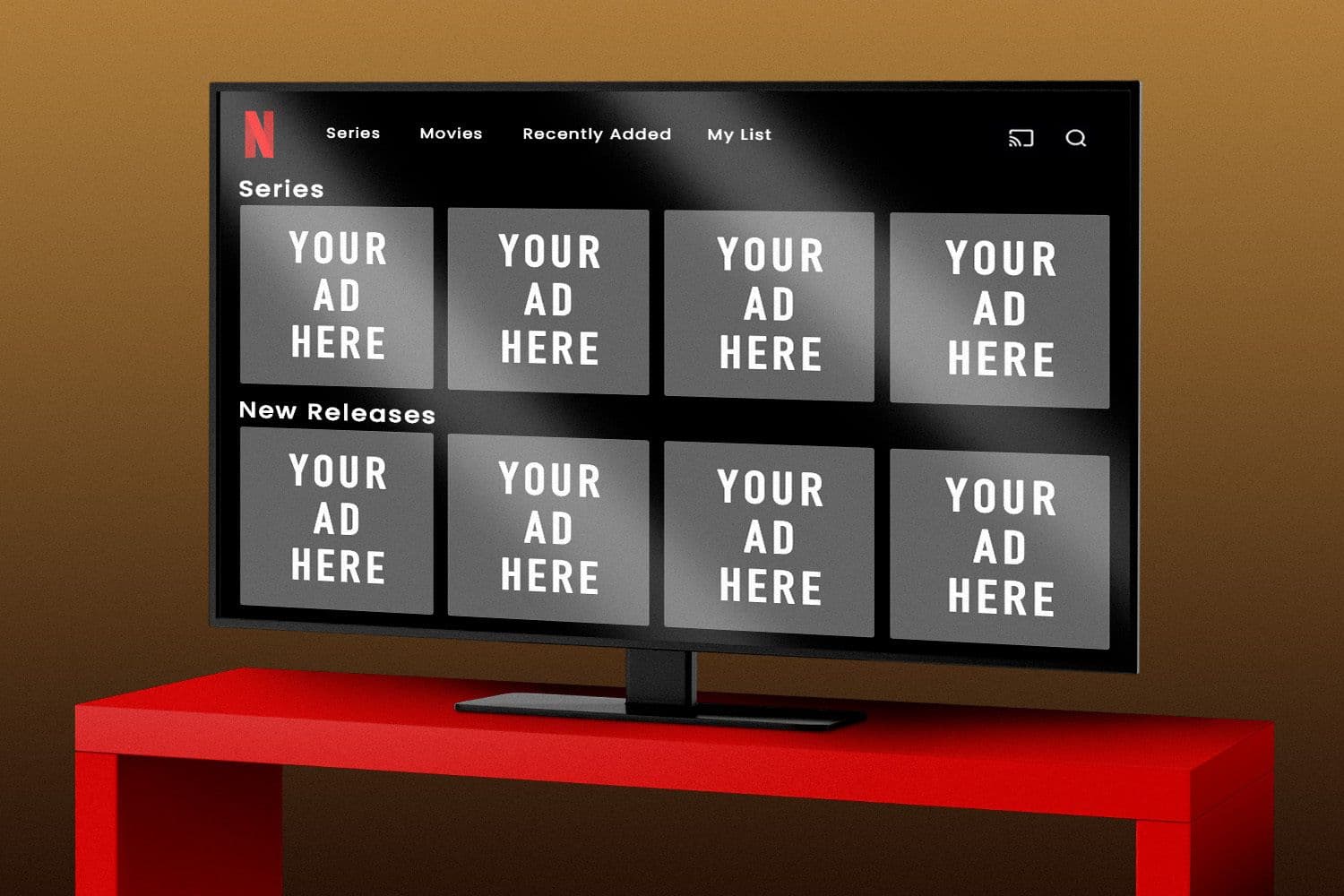Why an ad-supported tier on Netflix was inevitable
Lower-cost tiers are essential for continued growth.

Illustration: Francis Scialabba, Photos: Netflix
• 5 min read
In this world, nothing is certain except death and taxes—and in the case of streaming video services, ad-supported tiers.
This week, Netflix became the last of the big streaming hold-outs to bow to the advertising gods after reporting that it had lost subscribers for the first time in more than a decade.
“Those who have followed Netflix know that I’ve been against the complexity of advertising, and a big fan of the simplicity of subscription,” Netflix co-chief executive officer Reed Hastings said in an earnings call Tuesday. “But as much as I’m a fan of that, I’m a bigger fan of consumer choice and allowing consumers who would like to have a lower price and are advertising-tolerant get what they want.”
While it might take a year or two to figure out, Hastings said, “think of us as quite open to offering even lower prices with advertising as a consumer choice” in addition to a higher-priced, ad-free tier.
That sound you hear? It’s the sigh of relief throughout the advertiser and agency world, which has dreamed of running ads on Netflix for years.
“Finally!” said Kelly Metz, managing director of advanced TV activation at Omnicom Media Group, adding that the move was “inevitable.”
“One of our biggest challenges in advertising was the fact that so much of the streaming viewership was not reachable with ads,” Metz told Marketing Brew. “That is all changing with this new announcement, so we are going to have better reach in streaming, better scale in streaming. This is nothing but good news for our advertisers and clients.”
A long time coming
The sense of the inevitably of an ad-supported tier seems to have been well-known to just about everyone except for Netflix, whose executives said as recently as last month that there were no plans for an ad-supported tier. In a note this week, the research firm MoffettNathanson wrote that analysts “have long expected it and frankly wondered why [Netflix has] been so opposed” to an ad-supported offering.
A quick glance around the broader streaming landscape indicates why. Last month, Disney+, one of Netflix’s largest rivals, announced it would roll out its own ad-supported tier in the second half of the year. Other streaming platforms—including Discovery+, HBO Max, Hulu, Paramount+, and Peacock—all have ad-supported tiers, with many customers opting in to ads. Departing WarnerMedia CEO Jason Kilar recently said in an interview with Bloomberg that nearly half of all new sign-ups to HBO Max are to its ad-supported tier; On Hulu, the majority of users opt to watch ads, executives have previously said.
That success is proof enough. “I don’t think we have a lot of doubt that it works,” Hastings said, pointing to Hulu, Disney+, and HBO Max’s ad-supported tiers as examples.
Get marketing news you'll actually want to read
Marketing Brew informs marketing pros of the latest on brand strategy, social media, and ad tech via our weekday newsletter, virtual events, marketing conferences, and digital guides.
Free, ad-supported offerings are growing, too, including Roku—which is investing heavily in original programming—Fox-owned Tubi, and Amazon-owned FreeVee (until recently known as IMDb TV.)
“It was much easier for Netflix to stand its ground of being ad-free when it was one of the only major streaming players in the marketplace,” Mike Proulx, VP and research director at the research and advisory firm Forrester, told Marketing Brew. “But that’s just not the case now.”
The number of competitors and the quality of original programming across the streaming landscape is “causing a situation where an average consumer is feeling compelled to have to subscribe to multiple streaming services, for fear of missing out on what society and culture is buzzing about with some of these incredibly quality shows,” Proulx said. “That’s just not sustainable, for the average consumer to be paying for subscriptions for multiple streaming services, so something has to give.”
It’s something many consumers have indicated they want. In several global markets—including the US—consumers show a slight preference for low-cost, ad-supported streaming services compared to high-cost, ad-free services, according to recent data from Morning Consult. According to a December survey from Forrester, 44% of US online adults who use a streaming service would prefer that their favorite streaming service have commercial breaks so they can pay less.
Waiting for more
While Netflix has made efforts to grow its service’s offerings through original programming and mobile games, staying ad-free was no longer an option, especially as it regularly hiked prices to offset the growing investment in content.
“They can’t keep increasing their prices in order to make up for their revenue shortfalls,” Proulx said. “This is something that is simply inevitable, where they have to offer a different price point as a choice for consumers who are becoming increasingly price-conscious.”
As with most things, Netflix’s push into the advertising space will come down to the execution. Much still needs to be worked out, including what the ad-supported tier will cost, what ad formats will be available, and what partners Netflix may tap to build out its ad-targeting offering.
And while the news won’t affect this year’s upfront planning, Metz said, clients are already clamoring to know how they can get involved.
“I need Netflix to cooperate with me on establishing potential reach and establishing my total opportunity with them, just like I need that from all of my streaming partners,” Metx explained. “And I think that’s the nuance. As excited as I am about this news, it also means there’s a lot of work ahead.”
Get marketing news you'll actually want to read
Marketing Brew informs marketing pros of the latest on brand strategy, social media, and ad tech via our weekday newsletter, virtual events, marketing conferences, and digital guides.